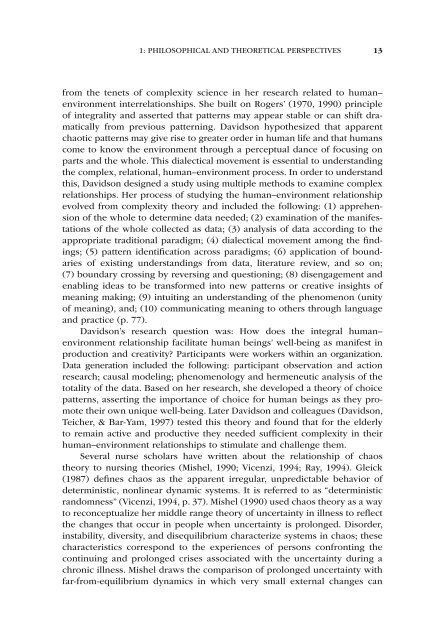Nursing, Caring, and Complexity Science: For Human ... - Axon
Nursing, Caring, and Complexity Science: For Human ... - Axon
Nursing, Caring, and Complexity Science: For Human ... - Axon
You also want an ePaper? Increase the reach of your titles
YUMPU automatically turns print PDFs into web optimized ePapers that Google loves.
1: Philosophical <strong>and</strong> Theoretical Perspectives 13<br />
from the tenets of complexity science in her research related to human–<br />
environment interrelationships. She built on Rogers’ (1970, 1990) principle<br />
of integrality <strong>and</strong> asserted that patterns may appear stable or can shift dramatically<br />
from previous patterning. Davidson hypothesized that apparent<br />
chaotic patterns may give rise to greater order in human life <strong>and</strong> that humans<br />
come to know the environment through a perceptual dance of focusing on<br />
parts <strong>and</strong> the whole. This dialectical movement is essential to underst<strong>and</strong>ing<br />
the complex, relational, human–environment process. In order to underst<strong>and</strong><br />
this, Davidson designed a study using multiple methods to examine complex<br />
relationships. Her process of studying the human–environment relationship<br />
evolved from complexity theory <strong>and</strong> included the following: (1) apprehension<br />
of the whole to determine data needed; (2) examination of the manifestations<br />
of the whole collected as data; (3) analysis of data according to the<br />
appropriate traditional paradigm; (4) dialectical movement among the findings;<br />
(5) pattern identification across paradigms; (6) application of boundaries<br />
of existing underst<strong>and</strong>ings from data, literature review, <strong>and</strong> so on;<br />
(7) boundary crossing by reversing <strong>and</strong> questioning; (8) disengagement <strong>and</strong><br />
enabling ideas to be transformed into new patterns or creative insights of<br />
meaning making; (9) intuiting an underst<strong>and</strong>ing of the phenomenon (unity<br />
of meaning), <strong>and</strong>; (10) communicating meaning to others through language<br />
<strong>and</strong> practice (p. 77).<br />
Davidson’s research question was: How does the integral human–<br />
environment relationship facilitate human beings’ well-being as manifest in<br />
production <strong>and</strong> creativity? Participants were workers within an organization.<br />
Data generation included the following: participant observation <strong>and</strong> action<br />
research; causal modeling; phenomenology <strong>and</strong> hermeneutic analysis of the<br />
totality of the data. Based on her research, she developed a theory of choice<br />
patterns, asserting the importance of choice for human beings as they promote<br />
their own unique well-being. Later Davidson <strong>and</strong> colleagues (Davidson,<br />
Teicher, & Bar-Yam, 1997) tested this theory <strong>and</strong> found that for the elderly<br />
to remain active <strong>and</strong> productive they needed sufficient complexity in their<br />
human–environment relationships to stimulate <strong>and</strong> challenge them.<br />
Several nurse scholars have written about the relationship of chaos<br />
theory to nursing theories (Mishel, 1990; Vicenzi, 1994; Ray, 1994). Gleick<br />
(1987) defines chaos as the apparent irregular, unpredictable behavior of<br />
deterministic, nonlinear dynamic systems. It is referred to as “deterministic<br />
r<strong>and</strong>omness” (Vicenzi, 1994, p. 37). Mishel (1990) used chaos theory as a way<br />
to reconceptualize her middle range theory of uncertainty in illness to reflect<br />
the changes that occur in people when uncertainty is prolonged. Disorder,<br />
instability, diversity, <strong>and</strong> disequilibrium characterize systems in chaos; these<br />
characteristics correspond to the experiences of persons confronting the<br />
continuing <strong>and</strong> prolonged crises associated with the uncertainty during a<br />
chronic illness. Mishel draws the comparison of prolonged uncertainty with<br />
far-from-equilibrium dynamics in which very small external changes can
















